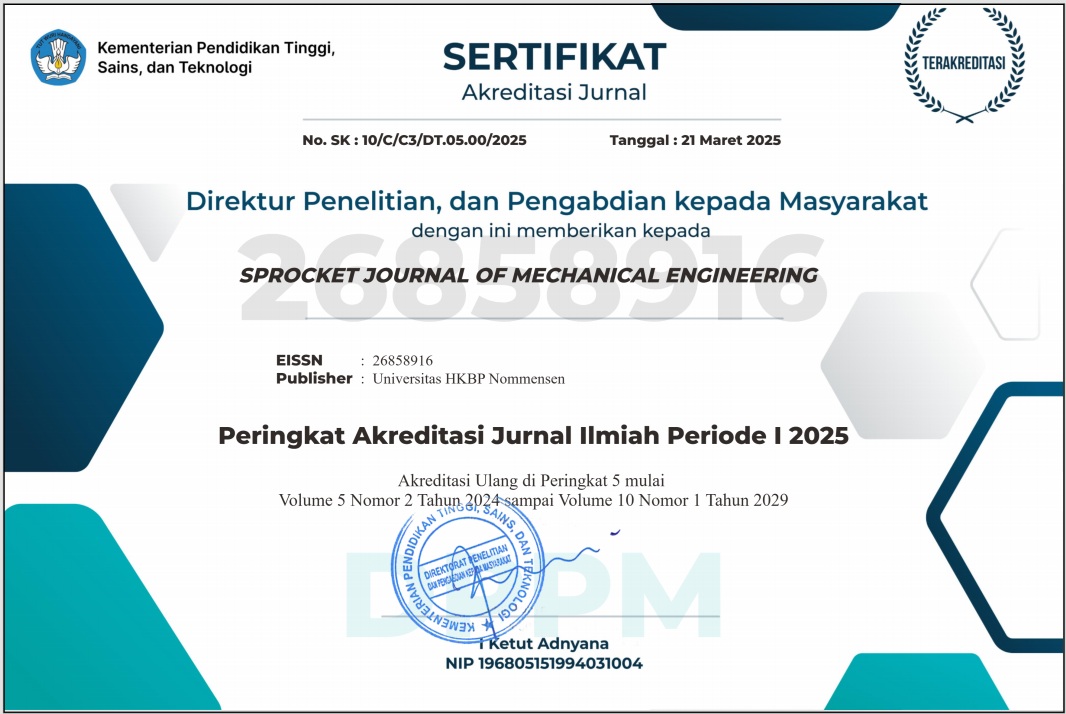Kinerja Peralatan Magnetik Untuk Meningkatkan Performansi Dan Mengurangi Emisi Gas Buang Pada Mesin OTTO Empat Langkah
Abstract
National energy data note that Indonesia fossil energy potential consisting of petroleum, natural gas and coal can only last for 10 years, 31 years and 80 years from now if no new fossil energy reserves are found. It is necessary to save energy to anticipate these conditions. One of the efforts that have been done is saving the consumption of fuel oil that is used in the internal combustion engine. This research aims to increase the performance by reducing fuel consumption and exhaust emissions by using magnetic devices. The equipment of magnetic is placed on the intake manifold which is varied 10 cm, 20 cm, and 30 cm from the combustion chamber to determine the effect of installing a magnetic field on the performance of the Otto engine. Gas emission analyzer is placed on the exhaust gas section. Besides that, there were also variations in engine speed consisting of 2000 rpm, 2500 rpm, 3000 rpm, 3500 rpm, and 4000 rpm. Experimental data show that there is an increase in power and thermal efficiency and a decrease in specific fuel consumption when the engine uses magnetic devices ranging from 5.99-22.02%. The exhaust gas emissions produced by Otto engine also decreased for CO and HC thereabouts 6-20%.
References
[2] Irvan et al 2017 IOP Conf. Ser.: Mater. Sci. Eng. 206 012028.
[3] X.,P, Pham, D.Q. Vo, R.N. Jazar, “Development of fuel metering techniques for spark ignition engines”, Fuel 206, 701-715, 2017.
[4] A. Yar, A. I. Bhatti, Q. Ahmed, “First principle based control oriented model of a gasoline engine including multi-cylinder dynamics”, Control Engineering Practice 70, 63-76, 2018.
[5] C. Yao, Z. Dou, B. Wang, M. Liu, H. Lu, J. Feng, L. Feng, “Experimental study of the effect of heavy aromatics on the characteristics of combustion and ultrafine particle in DISI engine”, Fuel 203, 290-297, 2017.
[6] G. Gonca, “Effects of engine design and operating parameters on the performance of a Spark Ignition (SI) engine with steam injection method (SIM)”, Applied Mathematical Modelling, S0307-904X(17)30106-3, 2017.
[7] A. Hasanain, A. Wahhab, H. Hussain, A. Al-Kayiem, R. A. Aziz, M. S. Nasif, “Survey of invest fuel magnetization in developing internal combustion engine characteristics”, Renewable and Sustainable Energy Reviews 79, 1392-1399, 2017.
[8] L. Liu, S. Chang, “Improvement of valve seating performance of engine’s electromagnetic valvetrain”, Mechatronics 21, 1234-1238, 2011.
[9] L.V. Polyacko, V.S. Morozova, V.S. Goun, “Environmental Performance Improvement in Gasoline Engines with External Mixture Formation”, Procedia Engineering 150, 1156-1161, 2016.
[10] Y. Xu, H. Kang, J. Gong, S. Zhang, X. Li, “A study on the combustion strategy of gasoline/diesel dual-fuel engine”, Fuel 225, 426-435, 2018.
[11] R. A. Kishore, S. Priya, “A review on design and performance of thermomagnetic devices”, Renewable and Sustainable Energy Reviews 81, 33-44, 2018.
[12] F. Ariani et al 2017 IOP Conf. Ser.: Mater. Sci. Eng. 277 012045.
Penulis yang menerbitkan dengan SPROCKET JOURNAL OF MECHANICAL ENGINEERING menyetujui ketentuan berikut :
- Penulis memegang hak cipta dan memberikan jurnal hak penerbitan pertama dengan karya yang dilisensikan secara bersamaan di bawah Lisensi Internasional Creative Commons Atribusi 4.0 . yang memungkinkan orang lain untuk berbagi karya tersebut dengan pengakuan atas kepengarangan karya dan penerbitan awal dalam jurnal ini.
- Penulis dapat membuat pengaturan kontraktual tambahan yang terpisah untuk distribusi non-eksklusif atas versi jurnal yang diterbitkan dari suatu karya (misalnya, mempostingnya ke repositori institusional atau menerbitkannya dalam sebuah buku), dengan pengakuan atas penerbitan awalnya di jurnal ini.
- Penulis diizinkan dan didorong untuk mengunggah karya mereka secara daring (misalnya, di repositori institusi atau di situs web mereka) sebelum dan selama proses penyerahan, karena hal ini dapat mengarah pada pertukaran yang produktif, serta kutipan yang lebih awal dan lebih banyak dari karya yang diterbitkan (Lihat Pengaruh Akses Terbuka ).






.png)
.png)

